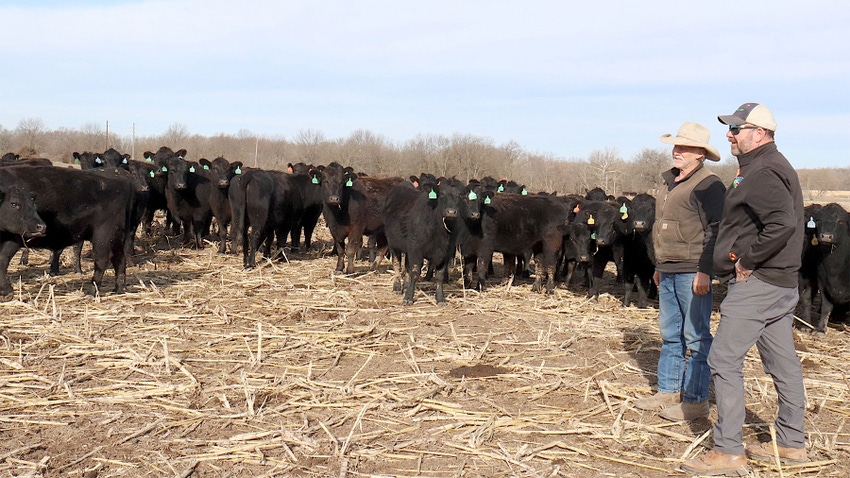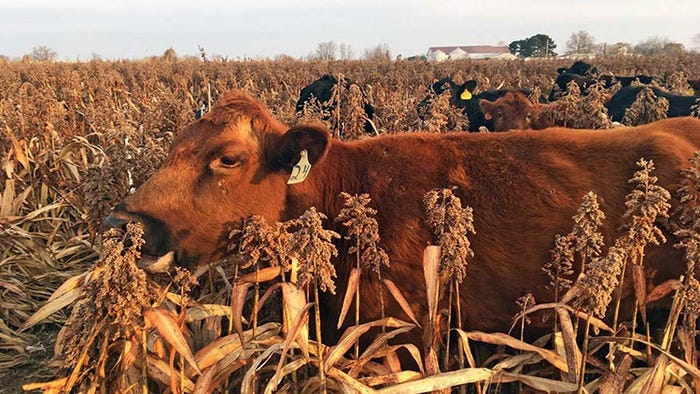
Staring at more than 600 head of Angus cows, a lingering drought and dwindling hay supplies, Missouri cattle producer John Chamberlin searched the internet for ideas to save his cattle herd. There, he found a University of Missouri Extension video on the benefits of grazing standing sorghum, or milo.
The Green Ridge, Mo., farmer reached out to the video’s creator, MU Extension agronomist Rusty Lee, nearly 130 miles away in Montgomery County to learn more. Then with the help of Pettis County MU Extension livestock specialist Gene Schmitz, the farmer, the agronomist and the livestock specialist met via Zoom.
“I have no feed,” Chamberlain told them. “If this milo thing doesn’t work, I’m going to have to sell cows.”
So, the trio went all in on a plan to grow sorghum during the 2023 drought. And the gamble paid off.

SAVINGS IN SIGHT: Missouri cattle producer John Chamberlin says sorghum grazing was “a home run,” saving him from buying 1,400 bales of hay this winter. Here, cattle are cleaning up one paddock of sorghum and stretching to reach a fresh paddock separated by electric polywire.
Chamberlin grew 115 acres of sorghum that made 80 to 90 bushels per acre. But it wasn’t enough to simply grow the feed. He needed to stretch it through the winter season, and that meant grazing standing sorghum.
Lee and Schmitz visited Chamberlin’s Henry County farm to see his operation, assess the grain yield and make recommendations on carrying capacity and daily allocation area size.
Making cows move for feed
While grazing standing sorghum was new for Chamberlin and his cattle, he says both adjusted to moving to a new paddock each morning.
At daybreak, he says, the cows were ready and waiting for him to move the polywire, allowing them access to more forage. The process was remarkably short, just 20 minutes, far less time than Chamberlain would spend putting hay into rings or rolling it out on the ground.

GAME PLAN: Missouri cattle producer John Chamberlin (left) visits with MU Extension agronomist Rusty Lee at his farm in Henry County about how the grazing sorghum plan worked out this winter.
However, during extreme cold spells this winter, he moved cows off sorghum to shelter and fed them hay.
By the end of the season, Chamberlin found that 115 acres of sorghum provided feed for 375 cow days per acre. Lee estimated yield between 80 and 90 bushels per acre.
Replacing hay cost
Sorghum grazing saved Chamberlin money.
He did not buy the typical 1,400 bales of hay this winter. Hay sold on the low end this year at $65 for a big bale, which would have cost $91,000. On the higher end, at $125 per bale, that’s a savings of $175,000 for his herd. He also saved time and labor.
That’s why sorghum grazing is a practice you can bank on, Lee says. “He’s really putting money in his pocket.”

MORE FOOD: MU Extension agronomist Rusty Lee has long promoted the practice of “taking cows to the feed rather than taking feed to the cow” by grazing standing sorghum, which saves time and money and provides good nutrition to the herd. Lee uses sorghum grazing on his own farm. (Courtesy of Rusty Lee)
Chamberlin’s only regret is that he didn’t plant more sorghum this year. In the coming months, he plans to broadcast a mix of cover crop seeds before planting sorghum again.
“Milo grazing is economical compared to buying hay, especially this year,” he says. “It’s always going to be a part of my program. It was a home run for me.”
You can see Lee’s video that piqued Chamberlin’s curiosity into sorghum grazing at youtube.com.
Growing sorghum
Sorghum’s drought resistance and low cost make it a good forage option, especially when hay is scarce and expensive.
It also solves the challenge of making hay in May, the month typically with the most rainfall. No longer do you have to worry about curing hay when there are clouds in the sky.
"You just sit there and watch your milo grow,” Lee says.
He offers these tips for planting sorghum for grazing:
Choose varieties for closed heads and good stalk strength or lodging scores.
Wait until soil temperatures reach 60 degrees F or more to plant.
Target planting for May to early June for grain production.
Sorghum for grazing performs best when planted in 30-inch rows.
Planting can follow winter wheat, but it’s best to allow the full growing season.
Don’t plant too thick. Your goal is to grow grain, not forage.
Use a preemergent herbicide for weed control. Once weeds emerge in sorghum, they are difficult to control.
Have a fertility plan in place. A split application of 120-150 pounds of nitrogen does well. Test soil for phosphorus and potassium needs.
Don’t force cows to graze to the dirt. Ideally, cows eat down to about 18 inches of stalk residue within two hours.
In the know on sorghum grazing
Sorghum for grazing has been an alternative feeding plan on Lee’s own farm in east-central Missouri for nearly a decade.
Here are some of his takeaways from years of on-farm research:
Fence it off. Using polywire electric fencing, the producer moves cows daily to a fresh paddock. Lee describes it as “taking the cows to the feed rather than taking the feed to the cows.”
Gain nutrients. Producers also see another benefit. The herd’s urine and manure retain soil nutrients taken up by the plants, so the nutrients are not exported off the farm as bushels of grain.
Calculate carrying capacity. Lee says an average sorghum yield of 120 bushels per acre is 6,720 pounds of grain. Taking into consideration the observed feeding losses of 25% as the cattle graze, that leaves 5,040 pounds per acre into the mouths of cows. Allocating 12 pounds of grain per cow per day yields a carrying capacity of 420 cow days per acre.
Graze at right time. Waiting two weeks after the fall killing frost before grazing avoids prussic acid concerns. Typically, a Nov. 1 start allows grazing all winter until the planted acres are consumed. While it is possible to graze sorghum until spring green-up of pastures, March winds combined with deteriorating stalk strength make it a good idea to conclude sorghum grazing by Valentine’s Day.
Gain energy for cattle. Composite forage tests of all plant parts consumed show total digestible nutrient values of 73% to 75% and crude protein of 7%. That is adequate energy, but requires protein supplementation, Lee says. Various commodity feeds such as soybean meal or high-quality hay can provide this.
Geist is a senior strategic communications associate for MU Extension.
About the Author(s)
You May Also Like




